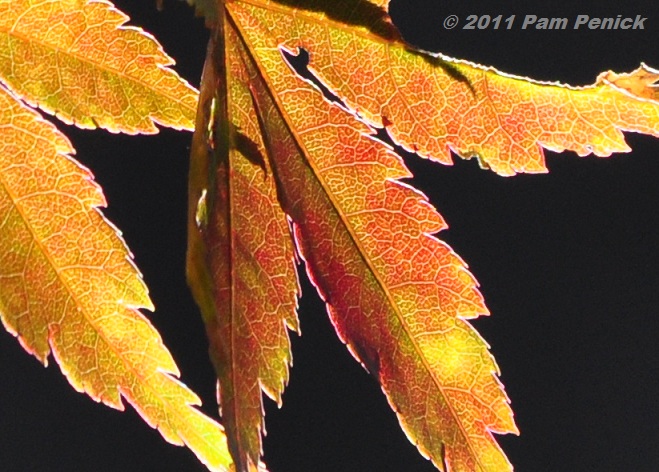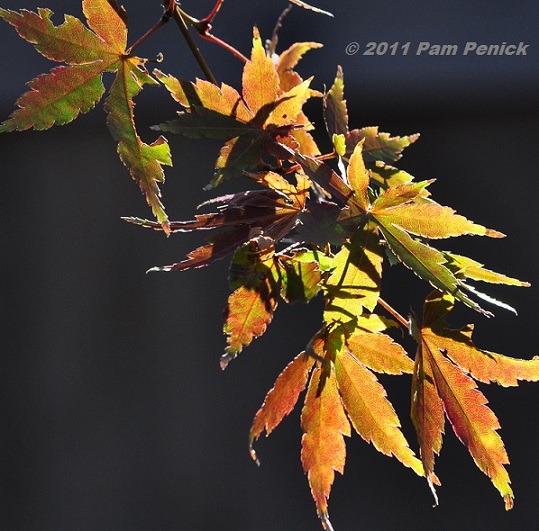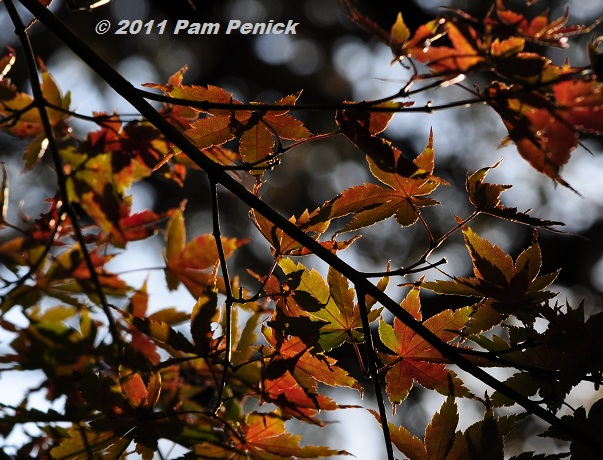Japanese maple leaves glow like stained glass
December 08, 2011
Our first hard freeze last night has coincided with the early coloring of leaves on my Japanese maple, a species Acer palmatum.
It normally blazes red by mid-December, but I wonder if the drought will affect its fall color.
I’ll soon know. Autumn is fading fast into winter, such as it is in evergreen central Texas.
All material © 2006-2011 by Pam Penick for Digging. Unauthorized reproduction prohibited.





Beautiful! I’ve always wanted one of these.
Do the deer bother it? That is our big problem here.
Stay warm….
Well, what don’t deer bother, Linda? You’d have to keep it caged for several years, I’m sure, as I do all my new trees, to keep deer from browsing tender leaves and bucks from rubbing their antlers against it. We inherited this fairly mature Japanese maple with the house. It’s tucked right up against the house, which has given it some degree of protection, but there are long, healed wounds on the trunk indicating that a buck damaged it with his antlers at some point. But a bigger issue for Japanese maples in our climate, of course, is the heat and drought. A cool, shady location is essential.
Lovely photos. I would love dearly to have a Japanese Maple, but alas, with our heat/drought, etc., I wouldn’t dare. I’ll enjoy yours through your pics.
My established tree held on pretty well in its northern exposure, shady spot up against the house. But, yeah, I wouldn’t plant one during the drought either. I’m only planting xeric, native trees this fall: Texas mountain laurel, golden leadball, Jerusalem thorn, etc. —Pam
I get the best ideas reading your blog. I have been trying to figure out a way to be successful with Japanese Maples, and voila peanut sandwiches, the perfect spot has just opened up in front of my house. It’s a northern exposure and as an added bonus my a/c discharge drips nearby. Does that sound like a good spot?
Thanks, Ally! A northern exposure has worked for my tree and extra water sounds good so long as the ground doesn’t stay soggy. I don’t think they like that, but I’m no Japanese maple expert. You might check with Dee at Red Dirt Ramblings in OK; she grows a number of them in hot, dry conditions. —Pam
They are somewhat difficult here as well, but their dainty elegance is just as irresistible.
Those leaves…that graceful form! There’s just something about them that makes us covet them. —Pam
Pam, I also think the scale(size and texture)of the tree fits better in a residential setting. Just south of here I have seen some palmatums 30 feet tall (the standard species). Believe it or not I have found that dissectum varieties seem to do better in more sunny positions than standard species.
Nice photos. My trees are done, color wise. I have two dissectums and two standard bloodgoods. I’m contemplating moving them, will see. G
When we lived in Raleigh, many years ago, we inherited a stunning and very large burgundy-leaf Japanese maple, which thrived in full sun and no special care (i.e., we never watered). Just goes to show how much hotter and drier it is here in Austin. —Pam
Hi Pam, I found you through Blotanical, I think we have things in common 🙂 And I also love acers, I have an Acer palmatum ‘Garnet’ which is now almost 8 years old. Would have loved to have several more, but as they are a bit fuzzy when it comes to sun and wind exposure I only have one place in my London garden suitable for acers, and that place is taken by my Garnet. Great photos you have!
Cheers!
Even if you have just one Acer, I think you can count yourself lucky. I know I do. Thanks for saying hi, Helene. —Pam